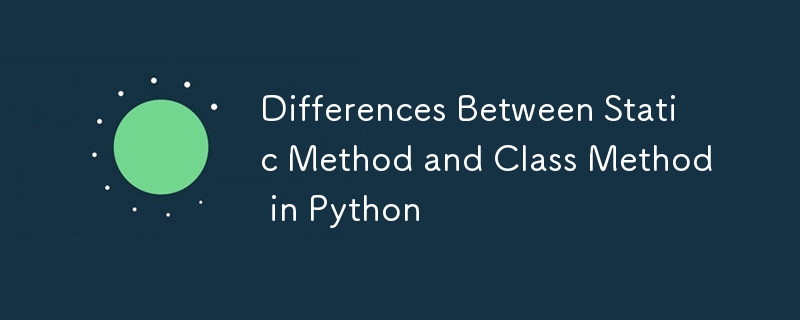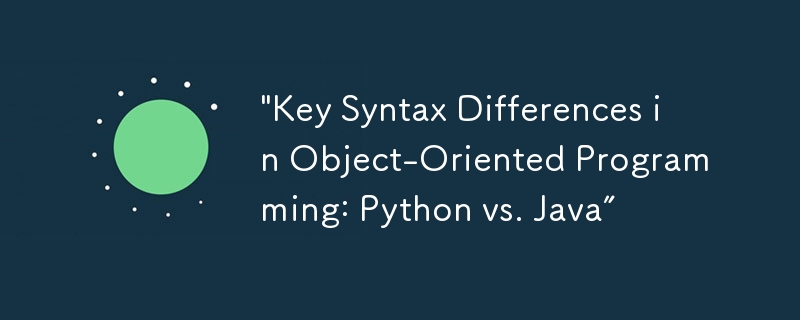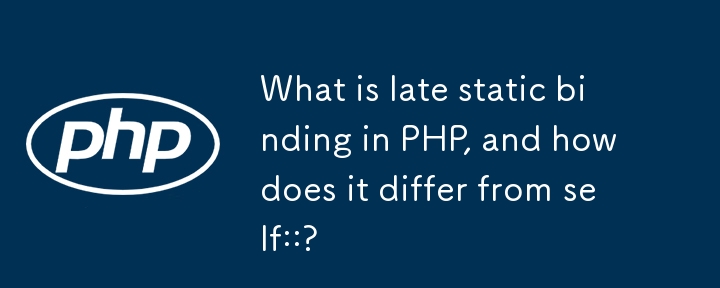
Course Introduction:The article explains Python classes, including definition, instantiation, key components like attributes and methods, and inheritance for code reuse. It also differentiates class and instance variables.
2025-03-19 comment 0 536

Course Introduction:The main differences between @staticmethod and @classmethod are parameter passing, usage scenarios and inheritance performance. 1. In parameter passing, the static method does not automatically pass any implicit parameters, while the class method automatically receives the class object as the first parameter (cls). 2. In terms of usage scenarios, static methods are suitable for tool functions that are independent of classes and instances. Class methods are suitable for factory methods or situations where class state needs to be accessed/modified. 3. In inheritance, the static method is still bound to the class at the time of definition when invoking, and the class method will be automatically bound to the subclass that calls it. When selecting, you should decide which decorator to use based on whether the class or instance is needed and whether it is used to create the instance.
2025-07-07 comment 0 399

Course Introduction:Object-oriented programming: Detailed explanation of classes and objects (Comparison of Python and Java) This article will use Python and Java code examples to compare and explain the concepts of classes and objects, as well as the usage of constructors. 1. Classes and Objects Python: # Student class definition class Student: name = "Momo" #Create object s1 of Student class s1 = Student() print(s1.name) Java: // Student class definition class Student { String na
2025-01-20 comment 0 862

Course Introduction:PHP traits enable code reuse in single inheritance contexts, offering benefits like reusability and simplified inheritance. They can be effectively combined with traditional inheritance to enhance class flexibility and modularity.
2025-04-30 comment 0 431

Course Introduction:In PHP, latestatic binding solves the limitations of self:: in inheritance through the static:: keyword. When using self::, it always points to the class that defines the method, not to call or inherit it; while static:: determines the target class at runtime, thus correctly referring to the subclass that is actually called. For example, if a method defined in the parent class is called by a subclass, self::class returns the parent class name, and static::class returns the child class name. 1. Use self:: to strictly refer to the current class definition; 2. Use static:: to support inheritance and allow subclass rewriting behavior; 3. Common application scenarios include factory mode
2025-06-17 comment 0 463

Course Elementary 13795
Course Introduction:Scala Tutorial Scala is a multi-paradigm programming language, designed to integrate various features of object-oriented programming and functional programming.

Course Elementary 82321
Course Introduction:"CSS Online Manual" is the official CSS online reference manual. This CSS online development manual contains various CSS properties, definitions, usage methods, example operations, etc. It is an indispensable online query manual for WEB programming learners and developers! CSS: Cascading Style Sheets (English full name: Cascading Style Sheets) is an application used to express HTML (Standard Universal Markup Language).

Course Elementary 13157
Course Introduction:SVG is a markup language for vector graphics in HTML5. It maintains powerful drawing capabilities and at the same time has a very high-end interface to operate graphics by directly operating Dom nodes. This "SVG Tutorial" is intended to allow students to master the SVG language and some of its corresponding APIs, combined with the knowledge of 2D drawing, so that students can render and control complex graphics on the page.

Course Elementary 24604
Course Introduction:In the "AngularJS Chinese Reference Manual", AngularJS extends HTML with new attributes and expressions. AngularJS can build a single page application (SPAs: Single Page Applications). AngularJS is very easy to learn.

Course Elementary 27464
Course Introduction:Go is a new language, a concurrent, garbage-collected, fast-compiled language. It can compile a large Go program in a few seconds on a single computer. Go provides a model for software construction that makes dependency analysis easier and avoids most C-style include files and library headers. Go is a statically typed language, and its type system has no hierarchy. Therefore users do not need to spend time defining relationships between types, which feels more lightweight than typical object-oriented languages. Go is a completely garbage-collected language and provides basic support for concurrent execution and communication. By its design, Go is intended to provide a method for constructing system software on multi-core machines.
Laravel Modal does not return data
2024-03-29 10:31:31 0 1 595
Can I use the automatic generation module of thinkphp5 in Windows 7 system? How to configure and use
2017-10-10 17:04:14 0 2 1394
2017-10-10 19:25:59 0 4 2947
To use mcrypt_get_key_size() in php study, how to enable mcrypt_
2017-10-10 19:47:34 0 1 1177
Detecting login status and preventing repeated login status in TP5 - My page is wrong
2017-10-10 22:49:15 0 0 1195